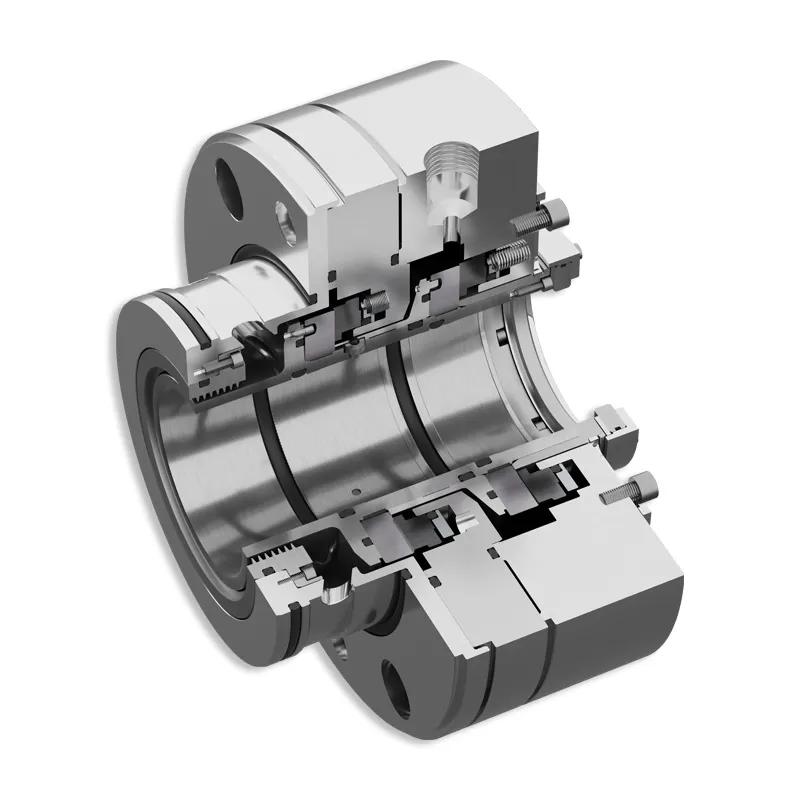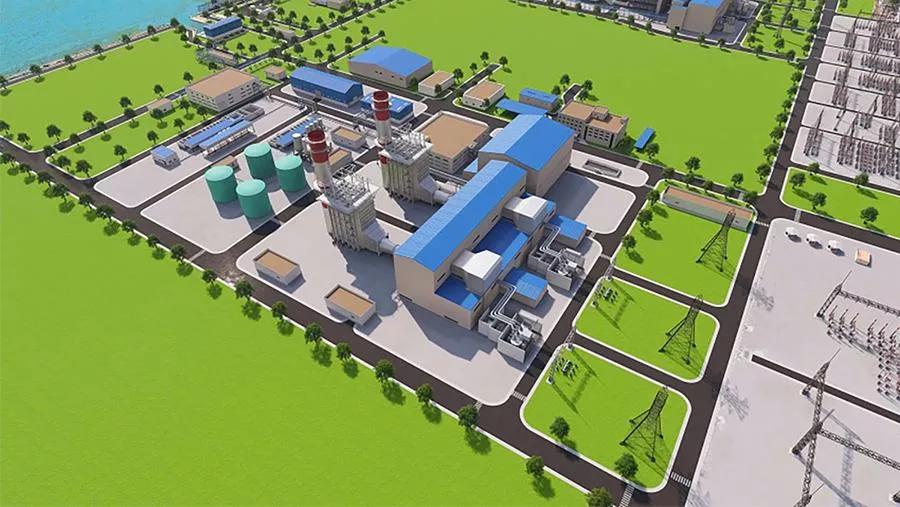News
Article
Turbomachinery Magazine
Reducing Methane Emissions in the Oil & Gas Industry
Author(s):
From ground-based technologies to site design and aerial innovations, the industry continues to use smart devices to abate methane emissions.
Methane, the main component of natural gas, is on the Environmental Protection Agency’s (EPA) hit list, calling it a climate “super pollutant.” Methane has a shorter lifetime in the atmosphere than CO2 but a greater near-term warming potential. According to the EPA, methane is responsible for approximately one-third of the current warming resulting from human activities and is a greenhouse gas (GHG) with a global warming factor 28 times higher than CO2.
The Agency released its final rule in late 2023 that will sharply cut methane and other GHG emissions from oil and gas operations—the nation’s largest industrial source of methane. The ruling includes revisions to the new source performance standards and emissions guidelines and promotes the use of methane-detection technologies.
The International Energy Agency (IEA) says methane abatement in the oil and gas industry is one of the cheapest options to reduce GHG emissions anywhere in the economy, and the industry has the largest potential for abatement in the near term. The energy sector accounts for nearly 40% of total methane emissions from human activity; oil and gas operations are responsible for 80 million tons of methane emissions.
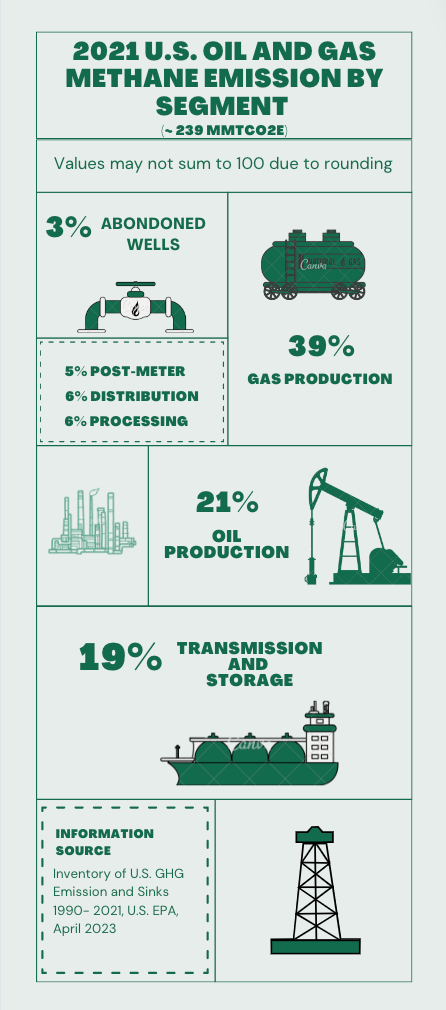
The solutions and technologies outlined by the EPA will prevent an estimated 58 million tons of methane emissions from 2024 - 2038. The EPA said the rule would achieve a nearly 80% reduction below the future methane emissions expected without the rule.
In IEA’s Net-Zero Emissions by 2050 (NZE) scenario, energy-related methane emissions decrease by around 75% by 2030—two-thirds of which comes from reducing oil and gas operations emissions. Further, more than 40% of the emissions reductions to 2030 in the NZE Scenario can be achieved with measures that would result in overall savings given the value of the captured gas. These measures include mechanisms to detect and immediately tackle large leaks, replacing pneumatics and pumps, and installing recovery systems. According to IEA, they would require just over 10% of the total spending on methane abatement and can produce results quickly, laying the groundwork for further reductions.
FROM FLARING TO FUGITIVE EMISSIONS
Toby Rice, President and CEO of EQT, said at the 2024 Baker Hughes Annual Meeting (AM) that more than 40% of natural gas producers have already signed on to meet zero or near-zero methane emissions by 2030. In addition to other efforts, EQT—the largest U.S. natural gas producer—is partnering to conduct aerial monitoring of an area the size of France to detect methane emissions.
The Italian energy company Snam is addressing methane abatement throughout its network: instrumentation upgrades to detect leakage and verify pipeline integrity, as well as equipment to capture and recompress methane gas to boost utilization and efficiency, according to Maria Sferruzza, Executive VP of International Engineering, Construction & Solutions at Snam, who also spoke at the Baker Hughes AM.
One of the big ways oil and gas companies such as bp have reduced their methane emissions is by eliminating flaring. bp aims for zero routine flaring by 2025 at its U.S. onshore operations and globally by 2030.
Saipem, an Italian multinational oilfield services company, also pledged zero methane leakage by 2030. At the Baker Hughes AM, Alessandro Puliti, the CEO and General Manager, talked about the company’s zero-flaring technology for power plants and other areas of the infrastructure to detect fugitive methane emissions.
“All new design and engineering for our new plants is done to ensure zero flaring and zero fugitive emissions while lowering the physical and environmental footprint,” he said.
One Saipem customer found a way to utilize boil-off gas from its LNG storage facility, which was previously flared or vented, thus improving the efficiency of the ecosystem.
From big-picture site design to hand-held detection cameras, actuators, and aerial technologies such as satellites, airplanes, and drones, the industry uses the latest technologies to detect, reduce, and eliminate leaks and methane emissions.
DESIGN-DRIVEN
As they say, less is more. And that’s true in the case of Chevron’s production facilities in the Mustang area in Colorado. The design, completed in 2022, only uses 7.5 surface acres versus the 400 surface acres usually required to deliver the same oil and gas production volume—that’s more than a 95% reduction in surface footprint. The minimal design also lowers lifecycle costs by 15 - 20%.
But it eliminates more than space. Because it produces spec oil direct-to-pipeline, there’s no need for big production tanks, flare systems, or further downstream processing facilities. In addition, flowback technology eliminates air emissions. This design can lower Chevron’s GHG by more than 90%.
Chevron's tankless facility design in Colorado. Credit: Chevron
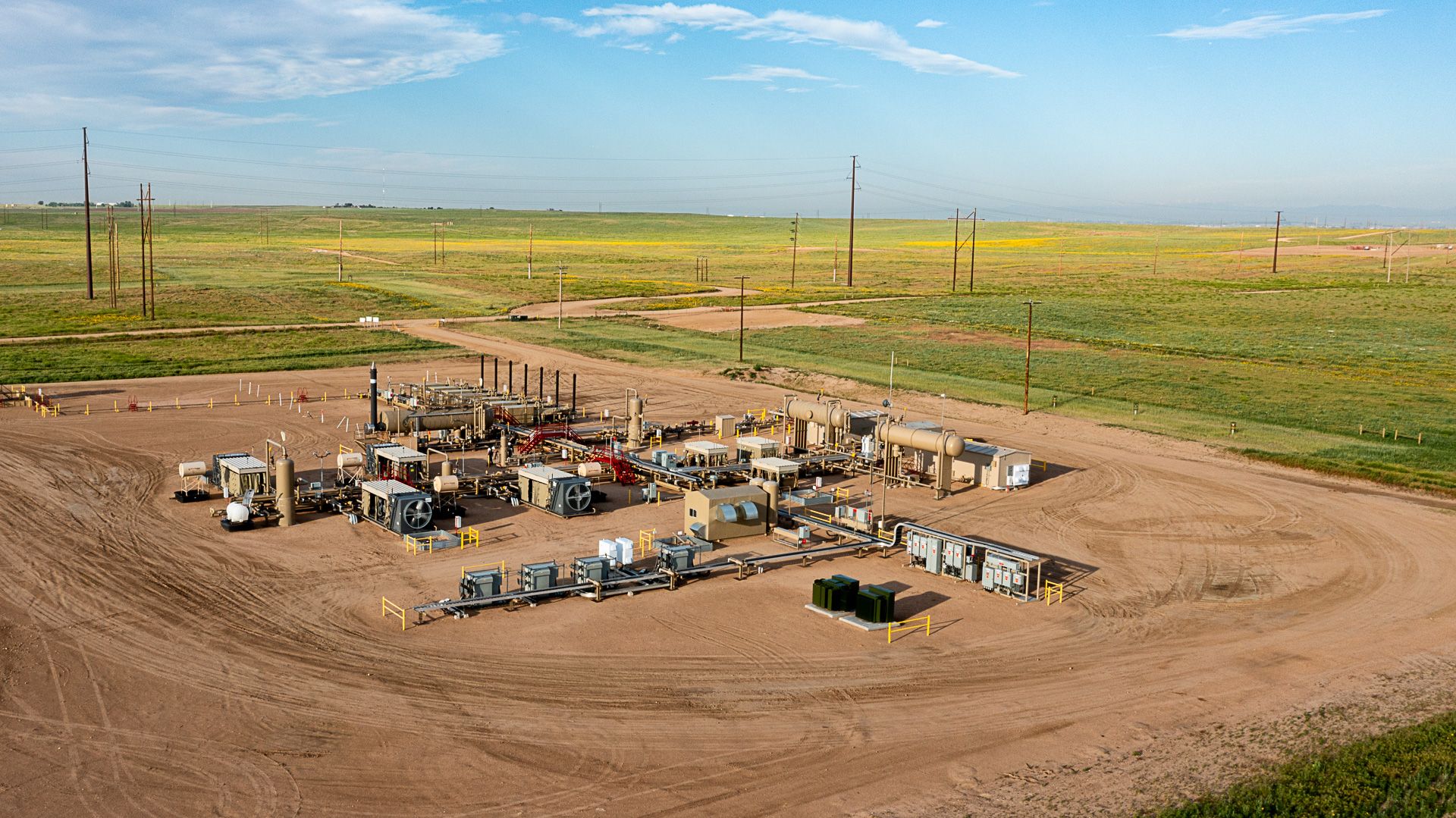
The company has been using utility electrical power since 2019 to drill 56 wells, and, when possible, uses grid electricity versus onsite generators to power the drilling rig. This step eliminates 100% NOx and other ozone precursor emissions during the summer months, and close to 75% in colder months when operations require boilers for heat. Plus, it eliminates truck traffic—the design cuts down on more than 152 million miles of truck traffic and associated emissions—and noise from the generators.
A spokesperson from Chevron told Turbomachinery International that its goal is simple: “Keep methane in the pipe. We believe methane reductions are possible in the energy industry, and in other key sectors, through the adoption of industry best practices, advancement in measurement technologies, carbon pricing, and methane regulations. Our methane strategy is focused on preventing methane emissions and using advanced detection technologies to validate performance, inform repairs, and improve inventories. We believe this approach can scale quickly across a global asset base, provide actionable information for methane emissions reduction, and augment emissions reporting as protocols become available.”
GROUND-BASED DETECTION TECHNOLOGIES
Oil and gas companies like Chevron use high-tech cameras, such as Teledyne FLIR optical gas imaging (OGI) cameras, in upstream and downstream operations to detect leaks proactively and for regulatory compliance. FLIR OGI cameras quickly scan broad sections of equipment and survey difficult-to-reach areas. They can also detect leaks from safe distances and display invisible gases as clouds of smoke.
“OGI cameras’ largest market is the detection of methane (and other hydrocarbons) in the oil and gas industry from upstream (well pads) to downstream (LNG or refineries),” said Craig O’Neill, the Global Director of Business Development at FLIR. “We also have business in renewable methane industries like biogas production, landfill gas-to-energy, and LNG markets.”
FLIR hand-held camera. Credit: FLIR

O’Neill said the biggest advantage of handheld OGI cameras is the “ground truth” that the technology shows. Once a leak is detected, the camera stores a video so the technician can share it with coworkers, repair personnel, or environmental professionals. “Many other technologies simply provide an ‘alarm’ that methane is present or a single snapshot image showing methane emissions. While these are great, they don’t tell the whole story of what is happening nor provide a true understanding of the emission event—is it a vent or a leak? Was it an intermittent emission event? Exactly what component is leaking rather than a general area where emissions are present?”
FLIR has cameras in almost every mid-to-large oil and gas operator in the upstream industry, ranging from a single unit to dozens.
Plus, OGI cameras also support the new methane-mitigation industry requirement to quantify emissions detected with technology. For example, the Bayernoil refinery complex in southern Germany integrated a gas detection camera into its leak detection and repair programs and used it to minimize hydrocarbon gas discharges from its piping systems, specifically leaks near flange gaskets.
IBS GmbH, headquartered in Bremen, Germany, conducts in-process analysis and detects gas leaks in biogas facilities. For IBS, using the FLIR GF320 camera not only significantly reduced the time it takes to scan a biogas facility compared to conventional gas detection technology, but it also enabled ground access to difficult areas such as where the tank meets the roof and the inner gas membrane. The case studies were similar for both BP Chemicals and Inspectahire, who said they were able to enhance safety and efficiency—the thermal imaging in FLIR’s cameras allows techs to keep a safe distance, when needed, to detect gas leaks and reduce repair downtime, among other benefits.
Teledyne FLIR optical gas imaging hand-held camera. Credit: FLIR

With the help of the NGIF Accelerator and its Emissions Testing Center (ETC) program, cleantech startups are developing innovations to tackle methane emissions. The program—operated by the not-for-profit arm of NGIF Capital Corp.—offers dedicated spaces via host sites for these companies to develop, test, and validate their solutions. The four-stage program includes access to the entire gas value chain, including a live gas operations environment.
Through the ETC program, Qube Technologies tested its fixed sensor that continuously, versus intermittently, monitors methane emissions. Since testing at the Tourmaline Oil/Perpetual Energy West Wolf Lake Plant—an ETC program host site—it has deployed over 4,000 sensors at over 1,000 sites, including Canadian operators such as Arc Resources, Enhance Energy, and Ember Resources.
SPACE IS THE LIMIT
Drones, satellites, and other detection technologies have helped many organizations significantly reduce their emissions. In fact, the Environmental Defense Fund reported on March 4, 2024, that MethaneSAT—a satellite designed to detect and quantify methane emissions—detached from SpaceX Transporter-10 into space. It will circle the Earth 15 times a day and measure changes in methane concentrations as small as three parts per billion.
To reduce emissions at its operations in the Permian Basin, ExxonMobil uses airplanes and helicopters to trail airborne technologies outfitted with methane sensors. It then integrates information collected from flyovers with data from ground-based mobile and fixed sensors remotely monitored from Houston. ExxonMobil said it “reduced methane emissions from all operated assets by nearly half as of year-end 2021 when compared to 2016” and eliminated 100% routine flaring in the Permian Basin, as per the World Bank Zero Routine Flaring Initiative.
PNEUMATIC DEVICES
Pneumatic devices comprise 40 – 50% of upstream oil and gas methane emissions. Rice said that a certain widely used pneumatic device at EQT turned out to be the company’s biggest source of methane emissions. The company replaced all 9,000 of these devices within 18 months, lowering companywide methane emissions by 70%.
Kathairos Solutions developed a system that uses liquid nitrogen, an inert gas, to power pneumatic devices, thereby replacing instrumental gas and eliminating the need for methane venting. It’s designed for smaller remote well sites, and its adaptable set-up is designed to minimize downtime and reduce operational disruptions.
Mitch Jones, Project Engineer at Kathairos Solutions, said the system gives customers the flexibility to set, commission, and fill the tank before tying it into their system, or Kathairos can facilitate this step. Within the first year of the unit’s commercial availability, 1,000 Kathairos units were installed and offset methane emissions by 40,000 metric tons of CO2 equivalent.
Jones said one of its customers in the Rockies region had over 140 tanks installed in less than three months, averaging five tanks installed and tied-in per day. This addressed the needs of 2,500+ wells and around 9,000 pneumatic devices, significantly reducing methane emissions from oil site pneumatics.
Another example from ETC program is Kinitics Automation, a Vancouver-based company whose roots are in the automotive and power-generation industries. The company developed an electric valve actuator to replace methane-venting pneumatic actuators. During tests at one of the ETC program host sites—the University of Calgary and its labs—the actuator’s positional performance was evaluated at a variety of temperatures. Outcomes revealed that the actuator reached the target positions within 0.1% at all tested temperatures and responded to motion commands of 0.25%—the smallest commanded value. In a differential pressure test, the actuator maintained a closed-valve state with a 4,000 kPa(g) differential pressure present across the valve. The electric valve actuator met or exceeded the performance of traditional pneumatic actuators.
UTILITIES
Duke Energy developed its Integrated Methane-Monitoring Platform (IMMP) to detect leaks and measure methane emissions on natural gas distribution systems. It uses a satellite with a short-wave infrared sensor to monitor methane emissions and ground-based technologies such as continuous monitoring sensors, gas cloud imaging cameras, and handheld/portable gas-sensing analyzers.
“IMMP started with satellite captures in Greenville, SC, which helped the team refine, improve, and scale the technology and the methane detection algorithms to various types of local distribution company assets with varying terrain and geography,” said Lauren Crowe, Managing Director of Natural Gas Business Transformation at Duke Energy.
IMMP has reduced recordable leaks in the Carolinas by more than 85% since its inception in 2022. “Duke Energy’s Natural Gas Business Unit is also using cross-compression technology to capture methane,” Crowe said. “We are also making investments in renewable natural gas, which is considered carbon-neutral because it removes methane from the atmosphere and displaces geological gas.”
The cloud platform ingests and calculates high volumes of real-time leakage data and then quantifies and prioritizes findings in graphic dashboards. Crowe explained that because the technology automates leak detection closer to the source, “pipeline management and operations teams can dispatch repair and maintenance crews to targeted sites for remediation based on near real-time information provided on cloud-enabled mobile devices. Using this method and technology enables us to identify and remediate any leaks in our system quicker and more comprehensively.”
Methane leakage detection. Credit: Duke Energy

The company’s extension program was selected by the U.S. Department of Energy’s Office of Fossil Energy and Carbon Management for nearly $1 million of funding. “As part of our IMMP extension project, we are testing a suite of both top-down and continuous-monitoring technologies with hopes of being able to detect and quantify emissions across all spatial and temporal scales and to evaluate the efficiency and accuracy of the various types of technologies,” Crowe said. The expansion project will include interstate, customer natural gas assets, upstream, and midstream. “The IMMP extension project will help us build a standard admissions, accounting, and reporting framework that will be useful across the entire value chain.”
To hear more about methane emissions in the oil and gas industry, check out our TurboTime podcast episode with the Myth Busters on methane leakage.
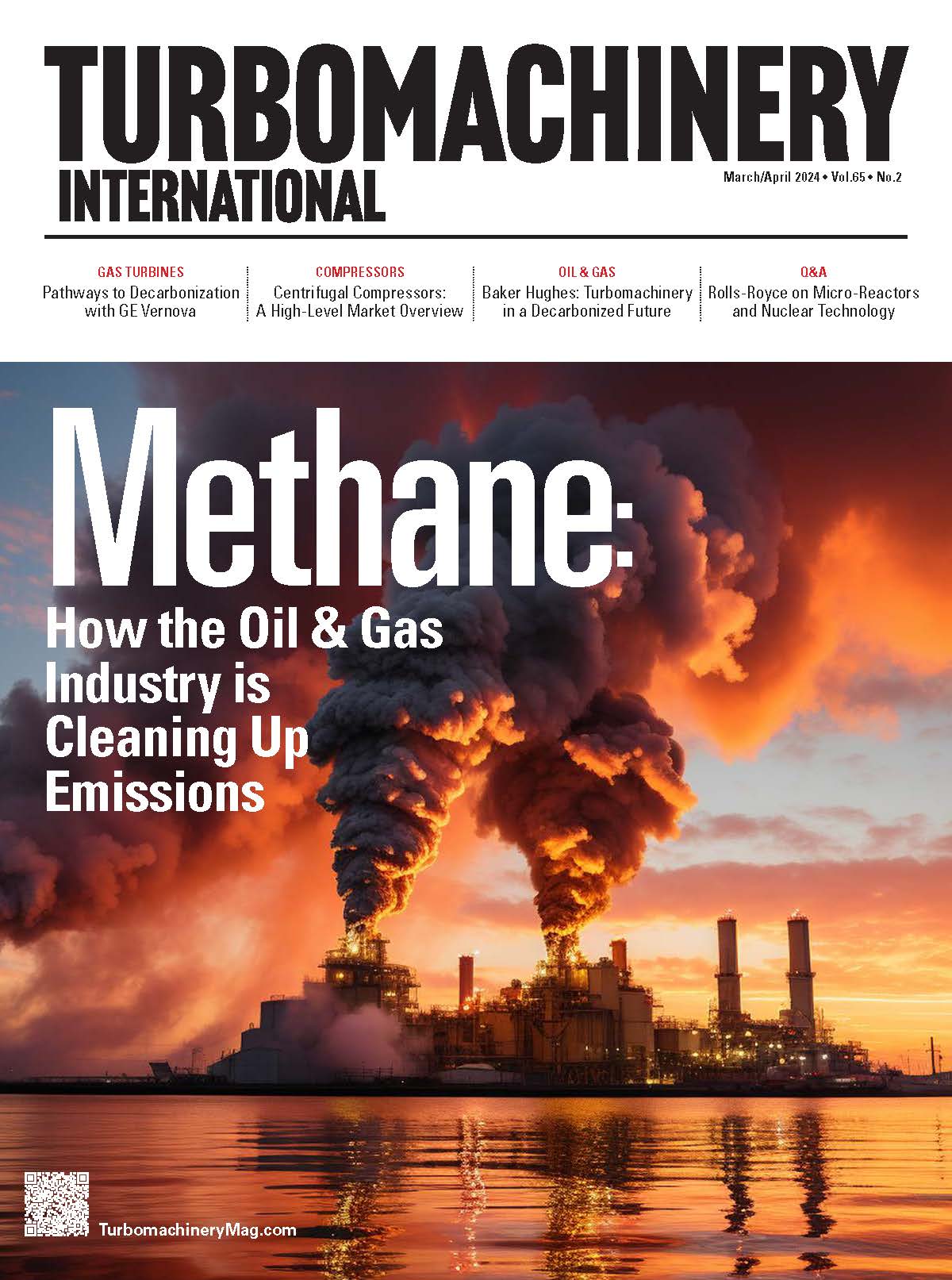
Newsletter
Power your knowledge with the latest in turbine technology, engineering advances, and energy solutions—subscribe to Turbomachinery International today.
